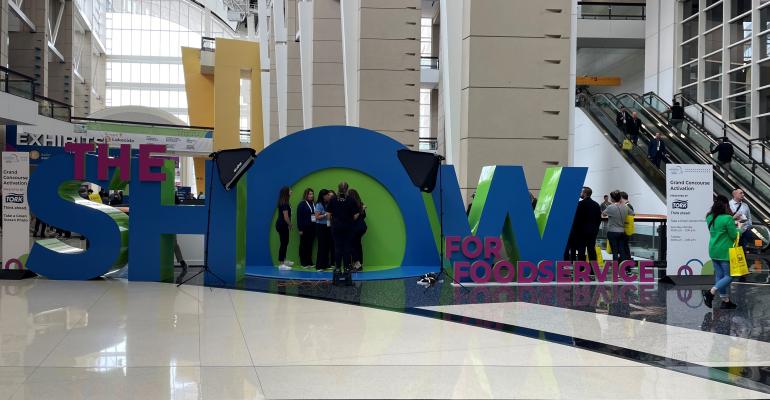The National Restaurant Association Show wraps up Tuesday in Chicago, and after three-plus days of hitting the show floor, we can say we have a pretty clear snapshot of why operators are here and what they’re looking for. Below are four takeaways from The Show (but do note these are nowhere near the only takeaways, as this show is humongous. Like, the size of 12 football fields-humongous).
Labor
California’s minimum wage increases went into effect less than two months ago and the consensus from many attendees we spoke to is that the $20-an-hour threshold will spread far and wide. As such, labor efficiencies are top of mind. Whether those efficiencies are achievable via tech solutions, retention, culture or something else, the search has become desperate.
“We’re getting more people this year asking us ‘how can you help us save on labor costs?’ Much more than last year. There’s more urgency. You can almost feel the weight,” said Julie Rudder from QSR Automations.
Ian Wren, from kiosk company Bite, said many operators stopping by his booth are from California and they’re asking not just about how kiosks can generate higher check sizes – as has been the case in the past – but also how they can help save on labor costs.
“Even just two or three hours a day at open or close at $20 an hour adds up,” he said.
This conversation, mind you, isn’t becoming more urgent just because of a $20 minimum wage, but also because employees are demanding simplicity more than ever. They’re also demanding more purpose and culture from their restaurant employers. That mindset shift comes courtesy of the pandemic and is worthy of the deeper conversation that is currently happening, according to gusto founder/CEO Nate Hybl.
“Investing in your people is sneaky capitalistic. Happier employees create happier guest experiences and revenues go up,” he said. “It’s a great way to grow a business.”
AI and automation
AI and automation solutions dominated the show floor even more than last year, but in sort of a different way. Sure, there were still burger flipping robotic arms and automated sushi makers, and even a couple of robots. But there were far fewer robots than last year and more so-called invisible tech solutions. Austin Prosser, a senior manager at Toast, said most people visited her booth to ask about AI and how it can benefit them for things like staffing to data usage.
“Last year, everyone was talking about robots. This year, they’re all talking about AI,” she said.
Meanwhile, on the automation side, there’s been a bit of an evolution.
“Last year, I felt like we were trying to automate the wrong things. I got into this industry because I like talking to people. I like cooking. I don’t need those things to be automated,” said Ben Pryor, president of Fourtop. “What I don’t want to be doing is counting the chicken in the freezer every night, inventory. Those are the kinds of things we should be automating.”
Sustainability
This industry has long strived to generate more sustainable solutions, but this year sustainability was a much, much bigger part of the spotlight as evidenced by the volume of exhibitors touting eco-friendly products. Most of these exhibitors were packaging companies promoting features like compostable, recyclable, PFAS-free, or aqueous coating.
Dave Lewis, with Detpak, said business is busier than it’s ever been, driven by increased regulations. He added that there is also a higher need for such solutions because of elevated delivery and takeout traffic, requiring more packaging.
Packaging certainly isn’t the only piece of this sustainability puzzle. More people are seeking food waste solutions both because it’s the right thing to do and because it’s a cost savings measure, according to Robb White of Leanpath.
“Operators realize this is a way to save money during a time they are looking for more ways to save money because of all the other costs they’re dealing with,” White said. “Plus, you’re not just wasting your food, you’re wasting the labor that went into making that food. We just can’t do that as an industry anymore. We’re running on tighter margins.”
Beverages
We know consumers want more specialty beverages and we definitely saw that reflected on the show floor – everything from energy drinks to matcha to boba. Lots and lots of boba. We also saw more choices for rimmers – beyond margarita salt. Twang had an entire display for its beverage accoutrements, from toppings and inclusions to coloring and coatings. The company just partnered with Coca-Cola, if you want to get a sense of how big this demand is becoming.
There were also more non-alcohol companies alongside the alcohol exhibitors, and even a couple of THC-infused drinks. Adam Peabody, CEO of Flora Hemp Spirits, said he has received “a ton” of inquiries from operators trying to understand how to incorporate his products into their business. That increased interest comes from a growing acceptability of THC products, as well as an increasing number of younger consumers abstaining from alcohol.
“Everything’s driven by the consumer. It’s very easy to see the opportunity in this category because cannabis is being legalized and normalized. More people are trying it,” he said. “I think in 5 to 10 years it will be a 50/50 market share split between THC-infused beverage and the alcohol category. It’s a generational thing.”
Contact Alicia Kelso at [email protected]
